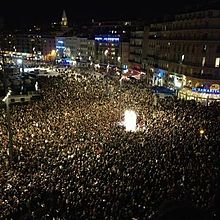Marseille-Provence 2013
The event is also considered an opportunity for a city or region raise its international profile and to foster urban renewal through investment in culture and tourism.
The association administrative council was led by Jacques Pfister, the president the Chamber of Commerce and Industry for Marseille and Provence.
The association had an initial budget of 91 million euros, 84% of which was provided via public financing (the European Union and various levels of French government).
The final budget for the association was 101 million euros, a sum that included the cost of running the ticket office and other initiatives.
The president of the Communauté du Pays d’Aix also threatened to withdraw after the headquarters of the newly formed Aix-Marseille University were placed in Marseille instead of Aix-en-Provence, but she later decided to maintain her community's participation.
There were various major events including a contemporary art walk in Aix-en-Provence and a pyrotechnical performance by Groupe F on the banks of the Rhône river in Arles.
The first examined the history of the Mediterranean people and their relationship with the sea and their cities, the second looked at the architect Le Corbusier, his ties to Marseille and his role in the Brutalist architecture movement.
This was a participative project that placed artists in developing urban areas to produce events or create art with local residents.
This programme was criticised because, despite large investments, the events had low visibility and were held irregularly so they didn't create any lasting cultural dynamic.
[19] Resident associations also denounced the project for being promotional tool for urban development programmes that were actually rejected by many locals and the source of political conflict.
This group actually foresaw the EEC and bought the domain name "marseille2013.com" and registered the trademark "Marseille 2013" in early 2004, prior to the official candidacy being launched.
Among the notable projects featured in the Off was Yes We Camp, an urban campsite in the northern part of Marseille, and the Klaxon series of exhibitions.
Designed by the Japanese architect Kengo Kuma, the conservatory was built to welcome world-class musicians and the best music students to the south of France.
The Fondation Regards de Provence created a museum in the former water treatment plant located beside the La Major cathedral on the port of Marseille.
Also located on the J4 quay, not far from the MuCEM, the Villa Méditerranée is "an international centre for Mediterranean dialogue and exchange" that was created by the regional government of Provence-Alpes-Côtes d’Azur.
The building for the Fonds regional d'art contemporain (FRAC) was designed by the architect Kengo Kuma and is part of the new Joliette business quarter.
Opened in 1993, the Musée d’histoire de Marseille is located in the Belsunce neighbourhood beside the Jardin des Vestiges, the ruins of the original Greek port.
The Vieux Port in Marseille was entirely transformed to become one of the largest public spaces in Europe with a complete reorganisation of the automobile traffic along its perimeter and the removal of barriers that impeded direct access to the sea.
[21] The Chamber of Commerce and Industry for Marseille and Provence determined that the additional tourism and extra spending related to MP2013 generated roughly 500 million euros in economic benefits.
[24] Marseille was named ‘European City of the Year 2014’ by The Academy of Urbanism in London, a professional association of more than 500 British designers.
One of the goals of MP2013 was to integrate art into public spaces and to involve people who weren't traditionally attending cultural events.
[29] The sociologist Sylvia Girel also published a report noting that many people weren't involved in MP2013, notably those in the poorer northern neighbourhoods of Marseille or the rural regions of Provence.


